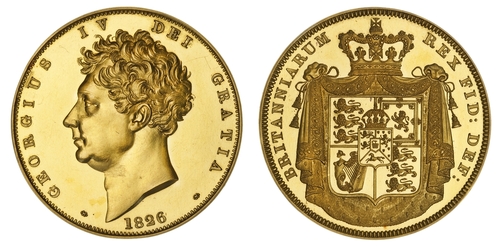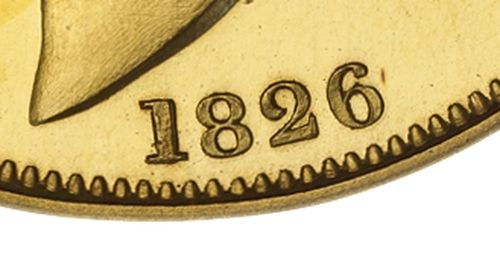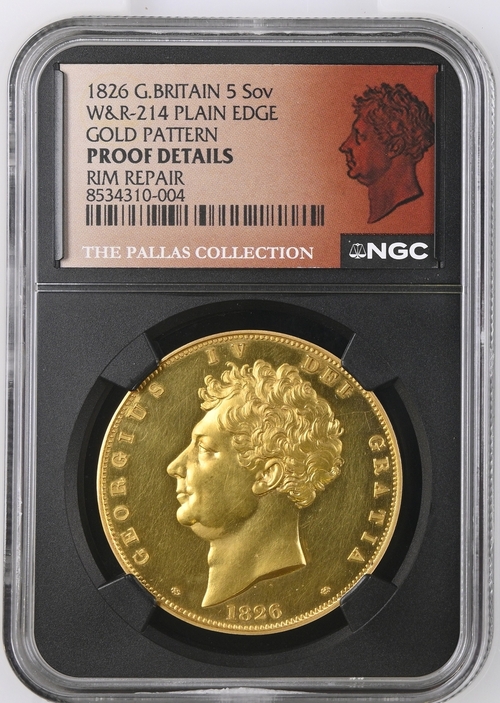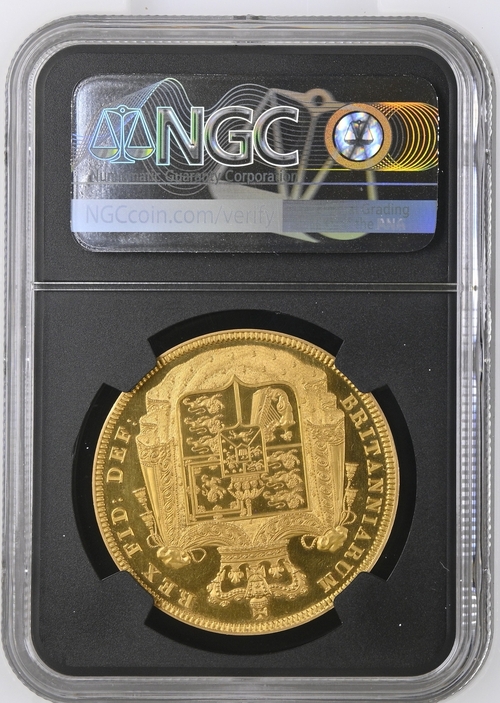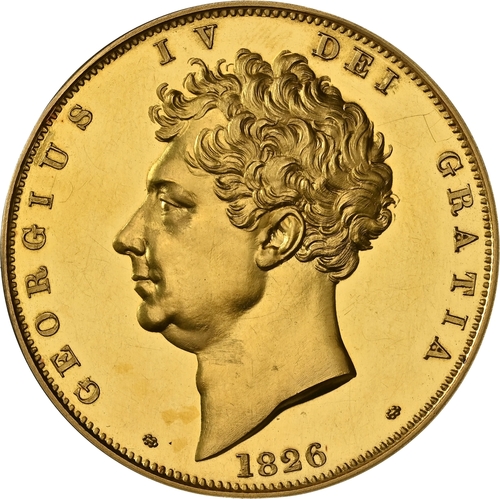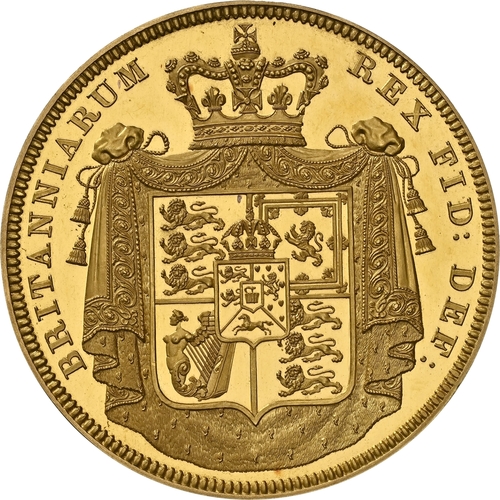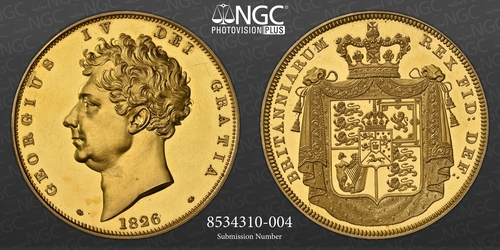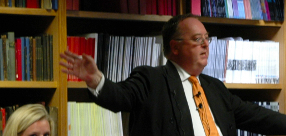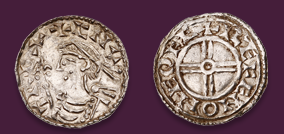Auction: 25005 - The Carrington and Pallas Collections of Exceptional English and Anglo-Gallic Gold Coins and Proof Sets
Lot: 460
(g) George IV (1820-1830), Specimen Plain Edge Five Pounds, 1826, 'Low 6', hot-struck in Experimental 22ct Binary "Yellow Gold" Alloy from Refurbished Proof Dies [c. 1827], GEORGIUS IV DEI GRATIA, bare head left, rev. BRITANNIARUM REX FID: DEF:, crowned shield in mantle, seven semée of hearts, edge plain, 39.797g [614.16grains], 12h (Hill F7; L&S 26; Hocking -; Douglas-Morris 170 [46.515g]; May 277 = Murdoch 363 = Nobleman 117 = Newcomer = "Traveller" 2151 [39.89g]; W&R 214 [R6]), minor wisps in otherwise sumptuously brilliant fields, with characteristic "orange-peeling" from Mint annealing processes; an exquisite and choice "VIP" Pattern, as if 'fresh from the die', OF THE HIGHEST RARITY with only THREE documented; unquestionably one of the most significant numismatic offerings to appear at public commerce in Britain; this being the influential 'trend-setter' for the metallic composition, dimension and subsequent global popularisation of the Five Sovereign Piece amongst cognoscente for nigh 200 years, proudly offered by Spink on the eve of its Bicentennial and with a most prestigious pedigree from the cabinet of a Senior Royal Mint Official, in NGC Black 'Pallas' holder, erroneously certified (Cert. #8534310-004)
Provenance
The "Pallas" Collection of English Coins
Seaby, by private treaty (ref. COMM 413), 4 September 1975 - £4,000
SCMB, April 1975, G227* and Front Cover - "Pattern Five Pounds , plain edge, 1826, FDC, RRR" - £7,500
~ Examined by E G V Newman of the Royal Mint, 23 December 1974 ~
"From the Cabinet of a High Mint Official, Deceased", Spink Numismatic Circular, July-August 1922, no. 6740 - “Of highest rarity, only one other specimen being known, which was successively in the Murdoch and “Nobleman” collections. In brilliant perfect state., F.D.C. - £50.0.0
Understood to be:
Robert Smith Mushet (28 November 1858 - 25 March 1925), a Barrister, died without issue, the remnants of his late Father's collection then offered at auction by Puttick & Simpson on 9 June 1925 (lots 163-243), but noteworthy in its omission of his great uncle's Pattern Five Sovereign, received in 1820 as documented in official Royal Mint records. It is this cataloguer's working assumption that the wide-spread publicity of the Nobleman sale in March 1922 and Spink's high profile spending at said sale prompted Smith Mushet to seek our appraisal of his heirlooms, ultimately selling the 1820 alongside this 1826, and an 1831 Gold Pattern and 1839 'Una and the Lion', when both Mushet Senior and Junior were in respective positions at the Royal Mint to acquire such exclusive examples direct from source. Their ongoing position as Refiner is interesting given the experimental 'hard alloy' composition utilised in the striking of this Pattern and other 'Barton's Metal' emissions at this time
Mary Anne Blakeway (Mushet) (27 October 1828 - 15 September 1913), died at Bushey, Hertfordshire, but lived at 29 Leinster Square, Bayswater, with her son, ~ thence to him ~
Robert Mushet [Junior] (26 October 1810 - 4 September 1871), Head of the Melting Department at the Royal Mint, ~ thence to his widow ~
Robert Mushet [Senior] (12 November 1782 - 1 February 1828), Master's First Clerk and Melter at the Royal Mint for the Great Recoinage, thence to his nephew
"X-Ray fluorescence spectrometry confirms the difference in densities, viz., that the Royal Mint coin [Hocking 1906: 1826 SEPTIMO] is a ternary 22 carat alloy consisting of gold alloyed with silver and copper whereas the Seaby coin is a binary 22 carat alloy consisting of gold alloyed with copper. No differences can be found in the obverse and reverse design details of the two coins. However, the table of the Seaby coin is "orange-peeled", i.e. the alloy crystals are of large grain size, whereas the Royal Mint coin has a normal smooth table. The "orange-peel" effect of the Seaby coin, is possibly, due to the fact that a binary 22 carat gold/copper is appreciably harder than a ternary 22 carat alloy containing silver in addition to the copper; therefore the former would need extra annealing with consequent grain (crystal) growth - in this case secondary recrystallisation appears to have occurred - in order to be soft enough to strike. The coin appears to be genuine, but the fact it is a binary gold/copper alloy rather than a normal ternary gold/silver/copper alloy of the period indicates that it was probably struck at a later date than 1826."
However, contrary to Newman's conclusion about 'a later restriking', compelling evidence has been unearthed to indicate experimental alloying and hot-striking techniques were entirely concurrent with the production of the SEPTIMO-issued Proofs for 1826 Specimen Sets. Lord Wallace is known to have ordered the striking of 'Fine Gold' Plain Edge Piedfort Proofs of the Five-Sovereign and Two Sovereign as a special commission for the collection of Charles Barclay during his short tenure as Master of the Mint (1823-1827). This very piece would later pass into the fabled trays of James Dodsley Cuff (1780-1853), of the Bullion Office at the Bank of England.
It is rather telling that a second specimen also featured in the private cabinet of the former Chief Cashier of the Bank of England, Frank May (1873-1893). It is noteworthy that during his tenure, May oversaw the dispersal of the Bank of England coin collection at Sotheby, Wilkinson & Hodge in July 1877. It is possible that May benefitted from first refusal of the trays before they were offered publicly, explaining the presence of an array of excessively rare Pattern Five Pounds of 1820; 1826 and 1831 alongside the 1889 'Full US Proof Set' ordered directly from his American counterpart in February 1889. Perhaps this also explains his rejection of the 1820 Pattern Five Pounds, on account of the plain edge already existing within his cabinet. It can only be speculated if he regretted subsequently turning down their Petition Crown on account of its piercing.
Frank May: 1873 to 1893
George Forbes: 1866 to 1873
William Miller: 1864 to 1866
Matthew Marshall: 1835 to 1864
Thomas Rippon: 1829 to 1835
Henry Hase: 1807 to 1829
https://www.ngccoin.uk/certlookup/8534310-004/NGCDetails/
Subject to 20% VAT on Buyer’s Premium. For more information please view Terms and Conditions for Buyers.
Sold for
£60,000
Starting price
£60000

